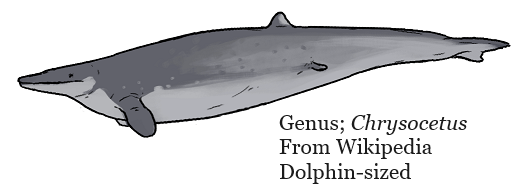12D: Chrysocetus
By Thomas Thurman
Also firmly in the basilosaurid family is the genus Chrysocetus currently known only through a single species; Chrysocetus healyorum which was described by Dr. Mark D. Uhen and Dr. Philip D. Gingerich in paper entitled “New genus of Dorudontine archaeocete (Cetacea) From the South Carolina Middle to Late Eocene” and published by The Society of Marine Mammalogy’s publication Marine Mammal Science in 2001.
This new genus and species of mid-sized basilosaurid; Chrysocetus healyorum was discovered in the Santee Cement Quarry (Formerly known as the Santee Portland Quarry) in Holly Hill, Orangeburg County, South Carolina. The genus name Chrysocetus is derived from the Greek work “chrysous” meaning golden, referring to the rich color of the fossils, and “ketos” meaning whale; so the golden whale.
The species name healyorum is in honor of Craig and Alice Healy from West Columbia, South Carolina who discovered the specimen which established the species.
The find was a sub-adult individual though it already possessed fully formed mature molars; they were serrated in the basilosaurid fashion and are considered more gracile than many basilosaurids.
The find included a partial skull, lower jaw, several teeth, many vertebrae, ribs, sternum, parts of the left forelimb, and pelvis.
The most current research shows that the sediments which produced the specimen are Priabonian in age. Very few additional individuals have been reported.
References:
Basilosaurid Evolution
A Review of North American Basilosauridae: Mark D. Uhen, 2013. Bulletin 31, Vol. 2, Alabama Museum of Natural History, April,1, 2013
